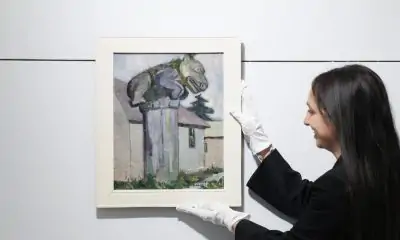Art
They Used to Award Olympic Medals for Art? – The New York Times

During all of the years that the Olympics gave out medals in arts, not just athletics — and if you didn’t know about that, the rest of this article may hold more surprises — the pinnacle came in Paris, 100 years ago this summer.
The gold medal sculpture at the 1924 Paris Olympics was by a Greek artist named Costas Dimitriadis. His nude, arching, 7-foot “Discobole” (Discus Thrower) was for weeks displayed prominently in the Grand Palais.
Two years later, before “a crowd of light-frocked women and straw-hatted men,” as The New York Times reported, the prized sculpture, cast in bronze, was planted just outside the Metropolitan Museum of Art in New York’s Central Park.
“A symbol of human perfection,” a museum official declared that day.
The statue did not stand still for long. Like the Olympic arts contests themselves, it went on quite a journey, largely to oblivion.
‘Pentathlon of the Muses’
For decades, beginning with the 1912 Olympics in Stockholm, the Olympics included competitions in painting, sculpture, architecture, music and literature — a “pentathlon of the Muses,” as Pierre de Coubertin, the founder and leader of the modern Olympics, called them.
“From now on they will be part of each Olympiad, on a par with the athletic competitions,” Coubertin said.
Thousands of artists, some of them famous, most of them not, submitted works. More than 150 Olympic arts medals were awarded, the same medals that athletes received. At the 1932 Olympics in Los Angeles, 400,000 people visited the monthlong exhibition of entries.
As the Olympics return to Paris this summer, thousands of gold, silver and bronze medals will be awarded — all for sport, none for arts.
“The spirit of Pierre de Coubertin did not survive,” said Nikoleta Tzani, a Greek art historian who wrote her doctoral thesis on Dimitriadis.
But some artwork did. It is scattered around the globe, some of it in museums or parks, some in private collections, much of it just lost to time and indifference.
In Lausanne, Switzerland, home of the International Olympic Committee, the Olympic Museum has a secured storage area in the basement. Curators oversee thousands of pieces of sports equipment, uniforms, medals, documents, torches, trophies — and art work.
But the only gold medal-winning paintings in the hidden collection are the two colorful pieces of a triptych that earned newspaper illustrator Jean Jacoby, of Luxembourg, first place in 1924. One represents soccer, the other rugby. The whereabouts of the third oil painting, depicting the start of a foot race, is unknown.
Upstairs, museum visitors learn all about Coubertin and see mementos of Olympic sports. There is no indication that the Olympics ever held serious arts competitions.
Outside the museum, though, overlooking Lake Geneva, a hillside garden is speckled with sculptures. A keen-eyed visitor might take note of one particular piece. It is Dimitriadis’ Discus Thrower, a late 20th-century copy of the one in New York.
“The original won first prize in the sculpture section of the art contest held during the 1924 Paris Olympic Games,” a nearby placard reads, cryptic enough to raise more questions than it answers.
Coubertin’s Vision
Coubertin, born in Paris in 1863, was raised in an aristocratic family and schooled in classical art and literature. He dreamed up the modern Olympics, based on the Games of ancient Greece, and launched them in Athens in 1896.
Like the Greeks, Coubertin believed that the Olympics should be about both body and mind. But just reviving the Olympics was difficult enough. The first three editions, to his frustration, featured only sports.
“Deprived of the aura of the Arts contests,” he once declared, “Olympic Games are only World Championships.”
In 1906, Coubertin invited dozens of artists and art figures to the Comédie Française in Paris. He proposed competitions in architecture, sculpture, painting, music and literature, “designed to be awarded every four years for unpublished works directly inspired by the idea of sport.”
He argued that athletics and academics should mix.
“The coming generation will know mental workers who will at the same time be sportsmen,” Coubertin said. “Are there not some already among the fencers?”
By day’s end, it was agreed: Art would be part of the Olympics, and medals would be awarded, beginning in 1912.
Nervous that he would receive too few submissions, Coubertin entered the literature contest himself. He submitted a florid “Ode to Sport” under the pseudonymous pairing of “Georges Hohrod and Martin Eschbach,” the surnames borrowed from the names of French villages.
In what could have become the first great I.O.C. scandal had anyone noticed before Coubertin died 25 years later, Hohrod and Eschbach won the gold medal. No other work was deemed worthy of a silver or bronze, including one by the Italian poet and novelist Gabriele d’Annunzio. (Another esteemed Italian who did not win? Sculptor Rembrandt Bugatti, of the famous car family.)
The next Olympics, planned for Berlin in 1916, were canceled by the war. The 1920 Antwerp Games were a patchwork affair held in the wake of the European devastation.
Then came Paris.
“It’s the most important arts competition,” said Christopher Young, a professor at Cambridge and co-curator of an upcoming exhibition at the Fitzwilliam Museum about the 1924 Olympics. “It’s the final year of Pierre de Coubertin’s tenure as Olympic president, it’s a moment of technological change, and the arts scene in Paris is very vibrant.”
The arts contests had found their time and place.
1924 and ‘The Liffey Swim’
While Jacoby’s winning entry from the 1924 Olympics is usually buried in storage, the painting that earned the silver medal is prominently displayed in a major European museum.
“The Liffey Swim,” an oil painting by Jack Butler Yeats, hangs in Room 14 of the National Gallery of Ireland, in Dublin. That it finished second to Jacoby’s triptych is a point of bemusement among art critics, and highlights the uneven judging of the Olympic arts competitions.
Jacoby is little known, at least outside of Luxembourg, where he has a small track stadium named for him and a bit of notoriety as only person to win two Olympic gold medals in art.
Yeats, by contrast, is considered Ireland’s most famous artist.
“He is a huge figure here,” Brendan Rooney, the National Gallery’s head curator, said. The museum owns dozens of his works — and his 1924 silver medal.
In 1923, the same year that his brother, the poet William Butler Yeats, earned the Nobel Prize in Literature, and just as Ireland was becoming independent, Yeats painted a modern scene depicting a swimming race down the Liffey River, through the heart of Dublin. The race remains a rambunctious part of Dublin’s summer calendar.
“It is an optimistic painting for a cautiously optimistic nation that had been through many very difficult years,” Rooney said.
The gallery’s accompanying placard notes that it “marks Yeats’ growing interest in Expressionism.” It is widely believed that Yeats had painted himself and his wife prominently within the crowd. “His ability to capture moments in crowds with figurative details was second to none,” Rooney said.
The painting was exhibited in London, Brussels and at the 1939-40 New York World’s Fair. With a laugh, Rooney suggested that Yeats had been the victim of artistic injustice, as his painting was modern and evocative compared to Jacoby’s conventional work.
Olympic entries skewed toward the classic and idealized, even in Paris in 1924. The Discus Thrower, the gold-winning sculpture later erected in New York, is a prime example.
“If you were a card-carrying member of the avant-garde or some kind of modernist society of the early 20th century, that wasn’t going to help you much,” Miles Osgood, a Stanford lecturer who has deeply researched the Olympic arts competitions, said. “It’s really fascinating to see how many of those artists were drawn to these contests, if only to lose them.”
Among those who submitted works but won nothing: the British poet and novelist Robert Graves in 1924, the Dadaist George Grosz, in 1928, and Walter Gropius, founder of the Bauhaus school of architecture, in 1932.
The best-known gold medal winners include French sculptor Paul Landowski and Dutch painter Isaac Israëls. Laura Knight, one of Britain’s premier female artists, earned a silver medal. That was all in 1928, a strong year for entries, buoyed by Paris in 1924.
Osgood sees Yeats’ medal-winning work reflected in the upcoming Olympics, where organizers hope to hold open-water swimming and part of the triathlon in the Seine River.
“‘The Liffey Swim’ comes to life in a new city,” Osgood wrote in an essay accompanying the Fitzwilliam exhibition. “If the Olympic Art competitions — with their rule books, juries and medals — once convinced art to imitate sport, it is now time for sport to imitate art.”
“The Liffey Swim” will be lent, along with Yeats’ silver medal, to the Fitzwilliam exhibit, scheduled to run from July 19 to Nov. 3. The Olympic Museum is sending the two Jacoby pieces, too. Art fans can judge them, side by side, as juries in Paris did 100 years ago, when Coubertin highlighted the arts at the 1924 closing ceremony.
“There is need for something else besides athleticism and sport,” he said. “We want the presence of national genius, the collaboration of the Muses, the cult of beauty, all the display pertaining to the strong symbolism incarnate in the past by the Olympic Games and which must continue to be represented in our modern times.”
They continued, but not for long.
End of an Era
The literature category of Olympic art rarely distinguished itself, but one entry for 1932 was illuminating. It was by an American, Avery Brundage, president of the American Olympic committee.
“Art, music, architecture, literature, all seem to have been prostituted in this commercial age to the greed for money,” Brundage wrote in “The Significance of Amateur Sport.” His words earned honorable mention but no medal.
Riding on momentum from Paris, the arts competitions coasted through Amsterdam in 1928 and Los Angeles in 1932. But at the Berlin Olympics in 1936, the competition fell under the direction of Joseph Goebbels, the Nazi propaganda minister.
There were international calls to boycott those Olympics, though Brundage notoriously supported American participation. France and Britain were among the countries that competed in athletics but had no arts entries. Americans had just one medalist, despite dozens of submissions. Germans dominated.
Coubertin died in 1937. World War II canceled the next two Olympics. When they resumed in London in 1948, the arts were a diluted part of the program. The United States did not participate.
A year later, Brundage, now the I.O.C. vice president, co-wrote a report on the state of the Olympics. Item 23 was about the arts. “Since art competition contestants are practically all professionals, Olympic medals should not be awarded,” the report said. “This event should be in the nature of an exhibition.”
There were other concerns. Unlike most sports, arts contests were subjective and ill-suited for the dawning age of television. The Olympics had blossomed into the pinnacle of sport, but not of art, not “on par with the athletic competitions,” as Coubertin had envisioned.
The 1952 contest in Helsinki was canceled, and in 1954, with Brundage now president, the I.O.C. voted to end the arts competitions.
They were mostly forgotten. But not by everyone.
From Paris to Randall’s Island
Patricia Reymond is senior collections manager for the Olympic Museum in Lausanne. On a weekday in March, in the quiet basement storage area, she pondered where all the Olympic art went.
“Of course we would love to have different pieces by the winning artists,” she said, standing near one of the Jacoby paintings. “But it is difficult.”
Researchers have lists of artists and artwork titles submitted for each Olympics, but descriptions are absent or vague. Artists sometimes created multiple works with similar titles, making verification difficult. Little was photographed, or was captured only in black and white.
Curators scan auctions and online sales. Language is a barrier. Not all advertised pieces are declared as having been a part of the Olympics.
Would curators notice if Carlo Pellegrini’s “Winter Sports” frieze, the first winning painting in 1912, went up for sale? (Probably, because its whereabouts have long proved vexing.) Would they catch it if “Rodeo” by Lee Blair, a Disney illustrator who won gold in 1932, hit the market? (Maybe. It was donated to a California high school and has been lost for decades.)
The case of the Discus Thrower might be the most illustrative. A Greek American tobacco executive named Ery Kehaya commissioned the first bronze version for New York. (A second was cast in 1927 and still stands near the historic Panathenaic Stadium in Athens.)
But a decade after its festive unveiling outside the Met, it was uprooted and replanted on New York’s Randall’s Island, in front of a new stadium where the sprinter Jesse Owens would qualify for the Berlin Olympics.
The sporting location made some sense, but New Yorkers have long been more likely to cross the bridges over Randall’s Island in a car or a train than to stop there. About 500 acres in size and virtually uninhabited, the island is where Manhattan, Queens and the Bronx are stitched together by the Robert F. Kennedy (formerly the Triborough) Bridge. Below is parkland and sports facilities, mostly, maintained by the Randall’s Island Park Alliance.
The organization’s logo is a silhouette of the Discus Thrower. Depicting an old-style, two-handed throwing form, it looks a bit like a muscular nudist leaning back to hand a loaf of bread to someone behind him in a crowd.
“Most people don’t know what it represents,” Deborah Maher, the alliance’s president, admitted.
The statue, like the stadium it proclaimed, did not age well. Worn, weathered and vandalized, missing an arm and the discus itself, it was quietly removed in 1970 and put in storage, and was not missed by many.
But the Discus Thrower was rediscovered, refurbished and rededicated in 1999. With the old stadium headed for demolition, it was placed on a grassy traffic island at the foot of a Manhattan exit ramp — a lonely greeter, to a mostly empty island. He didn’t even look drivers in the eye.
It stood there until last fall, when Maher and others got nervous about encroaching road construction. They hauled it away and, on April 16, the Discus Thrower was unveiled, again, outside the 5,000-seat Icahn Stadium, which had opened in 2005 on the site of the previous, larger stadium.
The statue is the centerpiece of a new $1.6 million plaza. It stands tall within a round, raised flower bed and is illuminated on four sides.
“We wanted to highlight him,” Maher said.
That this is 2024, the 100th anniversary of the Discus Thrower’s gold medal, the centennial of one Paris Olympics and the year of another, is a happy coincidence.
“The whole thing was serendipitous,” Maher said.
To be replanted in a raised flower bed on Randall’s Island may not represent the grandest of Olympic comebacks. But it’s a fate far better than that of the old arts competitions themselves, buried by history long ago.
Art
Duct-taped banana artwork auctioned for $6.2m in New York – BBC.com
[unable to retrieve full-text content]
- Duct-taped banana artwork auctioned for $6.2m in New York BBC.com
- A duct-taped banana sells for $6.2 million at an art auction NPR
- Is this banana duct-taped to a wall really worth $6.2 million US? Somebody thought so CBC.ca
Art
40 Random Bits of Trivia About Artists and the Artsy Art That They Articulate – Cracked.com
[unable to retrieve full-text content]
40 Random Bits of Trivia About Artists and the Artsy Art That They Articulate Cracked.com

Source link
Art
John Little, whose paintings showed the raw side of Montreal, dies at 96 – CBC.ca
[unable to retrieve full-text content]
John Little, whose paintings showed the raw side of Montreal, dies at 96 CBC.ca

Source link
-

 News17 hours ago
News17 hours agoEstate sale Emily Carr painting bought for US$50 nets C$290,000 at Toronto auction
-

 News17 hours ago
News17 hours agoClass action lawsuit on AI-related discrimination reaches final settlement
-

 News17 hours ago
News17 hours agoCanada’s Hadwin enters RSM Classic to try new swing before end of PGA Tour season
-

 News18 hours ago
News18 hours agoAll premiers aligned on push for Canada to have bilateral trade deal with U.S.: Ford
-

 News17 hours ago
News17 hours agoTrump nominates former congressman Pete Hoekstra as ambassador to Canada
-

 News17 hours ago
News17 hours agoFormer PM Stephen Harper appointed to oversee Alberta’s $160B AIMCo fund manager
-

 News17 hours ago
News17 hours agoEx-student pleads guilty to fatally shooting 3 University of Virginia football players in 2022
-

 News17 hours ago
News17 hours agoComcast to spin off cable networks that were once the entertainment giant’s star performers





















